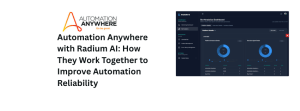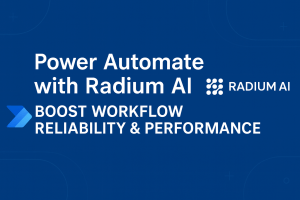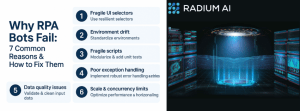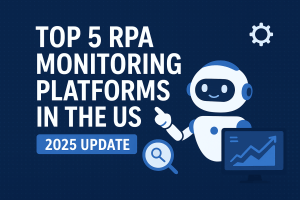How RPA Can Cut Your Workflow Time in Half.
In the race toward operational efficiency, businesses are increasingly turning to Robotic Process Automation (RPA to streamline routine tasks and accelerate service delivery. Yet, while many organizations implement RPA to eliminate manual work, they often hit a wall: lack of visibility, delayed error resolution, and inefficient scheduling hinder the full potential of automation.
This is where Radium AI steps in.
Radium AI acts as a command center for your entire automation ecosystem—monitoring, analyzing, and optimizing your RPA bots in real time. Here’s how it helps slash your workflow time by up to 50%, and sometimes more.
- Eliminate Human Monitoring with Smart Automation
Traditionally, RPA support teams dedicate Level 1 resources to monitor bots, check logs, classify failures, and triage incidents. Radium automates all of this:
- Real-time Monitoring: Radium connects to your Control Rooms and Orchestrators, continuously ingesting run-time data via REST APIs.
- Auto-classification & Ticketing: Built-in ML models instantly classify errors, determine the resolver group, and open tickets in your ITSM system—or use Radium’s internal ticketing.
- Auto-healing: If the issue is routine (e.g., retrying a failed bot), Radium takes corrective action immediately and closes the ticket without human intervention.
This alone eliminates hundreds of hours per month in manual monitoring and first-line support.
- Accelerate Resolution with Intelligent Recommendations
What happens when an automation breaks and no fix is prebuilt?
Radium’s ML models analyze historical failures and recommend proven corrective actions based on similar incidents. Even if a support engineer needs to step in, the troubleshooting time is cut significantly because Radium provides context, logs, and a recommended fix upfront.
For recurring problems, Radium’s low-code action designer allows teams to create workflows that are triggered automatically the next time the issue occurs—turning manual processes into self-healing automations.
- Dynamic Scheduling to Maximize Efficiency
One of the hidden inefficiencies in RPA is bot underutilization due to static or suboptimal scheduling. Radium uses dynamic scheduling to:
- Minimize the number of bots needed
- Avoid SLA breaches
- Match the right automation to the right device at the right time
The result? You can do more with fewer licenses, optimize infrastructure usage, and eliminate time wasted due to scheduling conflicts.
- Proactive Monitoring to Prevent Failures
Don’t just react to problems—anticipate them. Radium’s proactive monitoring scans your RPA environment for early signs of trouble, such as:
- Bots that didn’t trigger within expected windows
- Passwords nearing expiration
- System slowdowns and SLA threats
You define the rules, Radium takes care of the rest—alerting your team before issues become incidents.
- Measure Business Impact in Real Time
Radium goes beyond technical performance and delivers dashboards focused on business outcomes:
- Effort hours saved
- STP (Straight-Through Processing) rates
- High-impact automation failures
- Business unit and process owner visibility
By bridging the gap between IT and business, Radium helps you show real ROI and prioritize high-value automation opportunities.
Final Thoughts
RPA isn’t just about automating tasks—it’s about transforming the speed and reliability of your operations. But to truly cut workflow time in half, you need intelligent automation management.
Radium AI gives you the tools to do just that. Whether it’s through real-time monitoring, auto-remediation, predictive scheduling, or business-centric insights, Radium lets your automation work harder, smarter, and faster—so your people can focus on what really matters.








